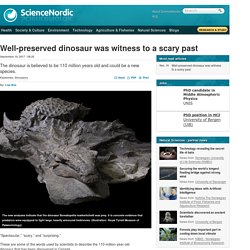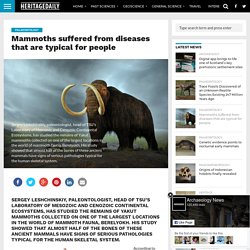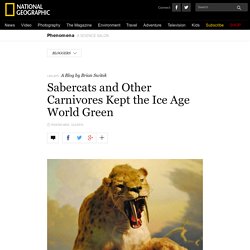

These Tunnels Were Dug by Giant Ground Sloths that Lived 10,000 Years Ago » TwistedSifter. Credit: Amilcar Adamy/CPRM Geologists in Brazil have discovered a series of incredible paleoburrows they believe were dug by South American megafauna, with a possible candidate being Giant Ground Sloths (Megatherium).

Okay that was a lot of big words in one sentence, so let’s define them: Paleoburrows: an underground shelter (tunnel, burrow, lair, etc.) excavated by extinct paleo-vertebrate megafauna that lived in the prehistoric era Megafauna: large or giant animals of an area, habitat, or geological period, extinct and/or extant The cave (seen above) was discovered in the Amazon and is nearly twice as large as the second-largest known burrow, located elsewhere in Brazil. The Amazing Dinosaur Found (Accidentally) by Miners in Canada. This article appears in the June 2017 issue of National Geographic magazine.
On the afternoon of March 21, 2011, a heavy-equipment operator named Shawn Funk was carving his way through the earth, unaware that he would soon meet a dragon. The 210-million-year-old Smok was crushing bones like a hyena. Ticks Trapped in Amber Were Likely Sucking Dinosaur Blood. Meet Beelzebufo, the dinosaur-eating "devil toad" Frogs are generally fairly harmless creatures (poisonous ones aside), but as with many animals their ancestors were far bigger and meaner.

The beach ball-sized Beelzebufo, or "devil toad", lived in Madagascar some 68 million years ago, and a new study suggests it may have dined on dinosaurs. By measuring the bite force of its living relatives, researchers were able to scale things up to estimate the jaw strength of the extinct big-mouthed behemoths, and found that dinosaur hatchlings may have been on the menu. Conducted by scientists from the University of Adelaide, California State Polytechnic University and University College London, the study measured the bite force of South American horned frogs with a custom force transducer. Well-preserved dinosaur was witness to a scary past. The new analyses indicate that the dinosaur Borealopelta markmitchelli was prey.

It is concrete evidence that predators were equipped to fight large, heavily armoured herbivores. (Illustration: Royal Tyrrell Museum of Palaeontology) Mammoths suffered from diseases that are typical for people – HeritageDaily. Our earliest mammalian ancestors likely skulked through the dark, using their powerful night-time vision to find food and avoid reptilian predators that hunted by day.

This conclusion, published by Stanford researchers April 21 in Scientific Reports, used genetic data to support existing fossil evidence suggesting that our distant relatives may have adapted to life in the dark. The team, led by Liz Hadly, professor of biology and senior author on the paper, examined genes involved in night vision in animals throughout the evolutionary tree, looking for places where those genes became enhanced. 70mn yo dinosaur eggs with embryos inside unearthed in Argentina. There Are Huge Tunnels in South America Dug By Extinct Giants Sloths. Deep inside Brazil, there are tunnels large enough for a person to walk through.

They are neatly symmetrical—too neat to have been caused by any known geologic process. And they are lined with claw marks. DNA clues to why woolly mammoth died out. Image copyright SPL The last woolly mammoths to walk the Earth were so wracked with genetic disease that they lost their sense of smell, shunned company, and had a strange shiny coat.

That's the verdict of scientists who have analysed ancient DNA of the extinct animals for mutations. The studies suggest the last mammoths died out after their DNA became riddled with errors. The knowledge could inform conservation efforts for living animals. Cave Paintings Help Unravel the Mystery of the ‘Higgs Bison' For 15 years, scientists have puzzled over the results of genetic tests from European bison remains that date back to the last ice age.

The DNA found in the bones and teeth of many animals contain sections of genome from an unknown bovine species, reports Jessica Boddy at Science. Researchers dubbed the creature “Higgs Bison,” a play on the Higgs Boson, the “God Particle” that eluded detection by physicists for almost 50 years. But now, cave art and further DNA testing have finally unraveled the origins of Higgs Bison, which turns out to be a previously undescribed hybrid animal. The research appears in the journal Nature Communications. The mystery first emerged when Alan Cooper, researcher at the Australian Centre for Ancient DNA at the University of Adelaide, and his team began sequencing DNA from ancient European bison to study past impacts of climate change, writes Eva Botkin-Kowacki at The Christian Science Monitor. Earth - What was Earth's first predator and when did it live? Around the world right now, thousands of animals are about to die.

The game is up for untold numbers of deep-sea fish, mountain-dwelling hares, subterranean earthworms and high-flying songbirds. They are all seconds away from becoming dinner for predators like lions, eagles and sharks. But when did this carnage begin? Have predators stalked the Earth since the origin of life itself? Or was our primordial planet once a Garden of Eden where species lived in peaceful co-existence? Sabercats and Other Carnivores Kept the Ice Age World Green. The huge herbivores of the Ice Age were ecosystem engineers.

Earth - The most powerful marine reptile ever. Earth - A pair of cave lion cubs has been found mummified. Incredible Study Demonstrates the Strong Likelihood That Dinosaurs Were Tripping out on LSD. Photo Credit: Shutterstock.com/agsandrew Was brontosaurus blissed out on prehistoric psychedelics as he munched the swamp grass in Southeast Asia 100 million years ago?

Scientists who have analyzed a perfectly preserved amber fossil from a cave there say it's entirely possible. The amber fossil contains evidence of the earliest grass specimens ever discovered—about 100 million years old—and that they were topped by a fungus similar to ergot, which has long been intertwined with animals and humans. Ergot is known as a medicine and a toxin. Storms bring forth prehistoric treasures. Tom Stienstr, San Francisco Chronicle By Tom Stienstra Updated 11:37 am, Sunday, December 21, 2014. Scientists "Resurrect" A 410 Million-Year-Old Spider With CGI.
Nest of Young Dinosaurs with 'Babysitter' Discovered. Long Before Trees Overtook the Land, Earth Was Covered by Giant Mushrooms. GSA press release - Giant Kraken Lair Discovered. Dinosaur Feathers Found in Ancient Amber. These feathers got stuck in a glob of amber millions of years ago. Image credit: Science/AAAS. The Sixth Mass Extinction? Dinosaurs With Attitude : Krulwich Wonders... Land Creatures Might Not Have Come From The Sea. Hide captionThe fossil remains of Dickinsonia, an Ediacaran organism that's long been extinct. Scientists have long assumed these early life forms lived in the sea, but a new study argues they emerged on land.
Tree-jumping taught dinosaurs to fly. Mammoth Clone? Preserved Pachyderm Has Living Cells, According To Siberia-Based Team. MOSCOW -- Scientists have discovered well-preserved frozen woolly mammoth fragments deep in Siberia that may contain living cells, edging a tad closer to the "Jurassic Park" possibility of cloning a prehistoric animal, the mission's organizer said Tuesday.
Russia's North-Eastern Federal University said an international team of researchers had discovered mammoth hair, soft tissues and bone marrow some 328 feet (100 meters) underground during a summer expedition in the northeastern province of Yakutia. Dinos' DNA Demise: Genetic Material Has a 521-Year Half-Life. From Nature magazine Few researchers have given credence to claims that samples of dinosaur DNA have survived to the present day, but no one knew just how long it would take for genetic material to fall apart.
New Dinosaur Was A Small, Fanged Vegetarian. Hide captionPegomastax africanus stood less than two feet tall and sported sharp fangs and a beak. Todd Marshall.